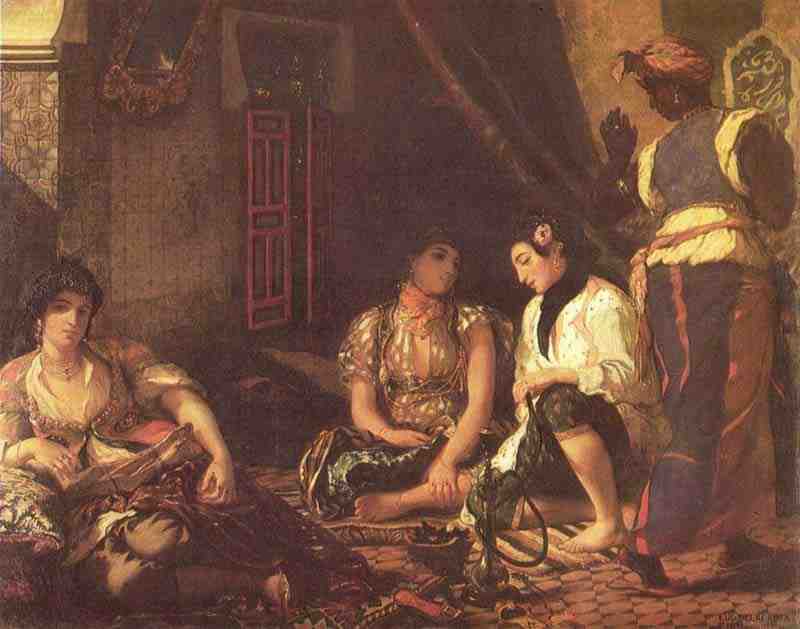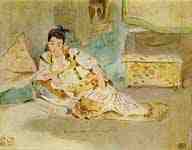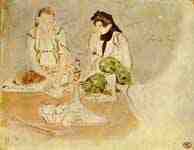
Women of Algiers , Eugène Ferdinand Victor Delacroix
1834, canvas, 180 × 229 cm
Paris, Musée du Louvre
-------
Frauen von Algier, Eugène Ferdinand Victor Delacroix
1834, Leinwand, 180 × 229 cm
Paris, Musée du Louvre
----
----
Fine Art Prints | Greeting Cards | Phone Cases | Lifestyle | Face Masks | Men's , Women' Apparel | Home Decor | jigsaw puzzles | Notebooks | Tapestries | ...
---
The Women of Algiers (In Their Apartment) is an 1834 oil on canvas painting by Eugène Delacroix. It is located in the Louvre, Paris, France. The painting was first displayed at the Salon, where it was universally admired. King Louis Philippe bought it and presented it to the Musée du Luxembourg, which at that time was a museum for contemporary art. After the death of the artist in 1874 the painting was moved to the Louvre, where it is held today.[1]
The painting is notable for its sexual connotations; it depicts Algerian concubines of a harem with a hookah, used to smoke hashish or opium. In the 19th century, it was known for its sexual content and its orientalism. The painting served as a source of inspiration to the later impressionists,[2] and a series of 15 paintings and numerous drawings by Pablo Picasso in 1954.[3]
History
The French conquest of Algeria had begun in 1830; toward the end of 1831 the young diplomat Charles de Mornay was sent to the Sultan of Morocco. At that time it was common to take artists along, in order to visually document such a journey.[4] Previously, when Delacroix was studying under Pierre Guérin, he had become friends with a fellow student, Henri Duponchel, who had recently become director of scenic design at the Paris Opera (and would later become its managing director). Duponchel was in the social circle of Mornay's mistress, the actress Mademoiselle Mars, and recommended Delacroix for this assignment.[5][6]
In contrast to the chief of the diplomatic mission, who missed Parisian life and found the region and its people simply barbaric, Delacroix greatly relished the atmosphere, the colors, the objects, the people, and the architecture of this exotic world. All the same, Delacroix recorded in his notebook that although North Africa seemed surrounded by beauty, in regards to human rights and equality before the law there was much in need of improvement.[6] Because Islam forbade all naturalistic images and women were veiled in public, it was difficult for Delacroix to find female models to draw from; men predominate in his sketchbooks. As soon as he would seek to sketch from afar the women who would hang their washing out on roof terraces, they would immediately alert their husbands.[1] He was only let into Jewish households; there he would later paint the Jewish Wedding and The Jewish Bride.[7] Thus he had no luck in Morocco. He finished his sketches for this painting at the last moment in Algiers, which by then was securely held by the French, where he lingered for a few days on the way back to France. A former Christian who had converted to Islam and had collaborated with the French, is supposed to have allowed him entry into his Harem.
Having walked down some dingy corridor, you enter the part of the house which is reserved for [the women]. The eye is truly dazzled by the bright light, the fresh faces of the women and children amidst a mass of silk and gold. For a painter, it is a moment of fascination and strange happiness.
The harem

The Women of Algiers (study). 1832, 10×13cm, Louvre (Mounay ben Sultan, left woman)

The Women of Algiers (study). 1832, 10×13cm, Louvre (right group)
Harem scenes in paintings and books were very popular in Delacroix's time. French Orientalist painting took off with Napoleon's Egyptian campaign of 1798, the year in which Delacroix was born. A further high point followed the French enthusiasm for all things Greek during the Greek revolution in 1821-30, during which time Victor Hugo authored the volume of poems Les Orientales and Delacroix contributed two paintings, The Massacre at Chios (1824) and Greece Expiring on the Ruins of Messolonghi (1826), a forerunner of his most famous painting Liberty Leading the People (1830).
European men made the Harem out to be a kind of plush private bordello; this painting has more than a little of this notion in it. The problem for European artists was that no European could obtain access to a Harem. Their fantasy depictions of it were therefore obviously pure inventions and often hardly believable. (see Jean-Léon Gérôme's 1876 Pool in a Harem, for example) In contrast, Delacroix could rely upon his own eyes, which lends his work a special heft, believability and authority.
Nevertheless this painting reflects anything but reality, but rather presents a mixture of observation and generally accepted European conventions. Other than the black slave, who appears to be leaving the room, the women are conspicuous in their luxurious idleness. In reality, however, the Harem would be teeming with children and all kinds of activities- the women would have been in no way alone and idly awaiting the return of their man.[6] This is even more amazing as Delacroix himself noted in his journal that children were not to be overlooked. The natural and domestic setting thus becomes a bordello, such as would have been easy to find in Paris.
Footnotes
^ to: a b Hagen, p. 361
^ "Women of Algiers" by Eugène Delacroix [Selected Works]
^ Picasso: Challenging the Past National Gallery p 109-114
^ Pages from the Morocco Notebook 1832, watercolor, 19×13cm. Musée du Louvre, Departement des Arts graphiques, Paris. Accessed on 13 September 2010
^ Marrinan 2009, pp. 195–196.
^ to: a b c Hagen, p. 358
^ The Jewish Bride. 1832, watercolor, 29×24cm, Musée du Louvre, Paris
References
Eugène Delacroix: Journal de Eugene Delacroix ... precede d'une etude sur le maitre par M. Paul Flat; notes et eclaircissements par MM. Paul Flat et Rene Piot ... E. Plon, Nourrit et cie., Paris 1893. (Various formats) Accessed on 13 September 2010
Eugène Delacroix, Gilles Néret: Eugene Delacroix, 1798-1863: The Prince of Romanticism (Basic Art). Taschen GmbH, Cologne 2000, ISBN 978-3-8228-5988-9
Marrinan, Michael (2009). Romantic Paris: Histories of a Cultural Landscape, 1800–1850. Stanford, California: Stanford University Press. ISBN 978-0-8047-5062-2.
Rose-Marie Hagen, Rainer Hagen: What great paintings say, Volume 2 Taschen Verlag, Cologne 2002, ISBN 978-3-8228-1372-0. Google Books Accessed on 13 September 2010
External links
Eugène Delacroix (1798-1863): Paintings, Drawings, and Prints from North American Collections, a full text exhibition catalog from The Metropolitan Museum of Art, which discusses The Women of Algiers
Retrieved from "http://en.wikipedia.org/"
All text is available under the terms of the GNU Free Documentation License


